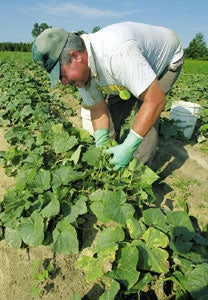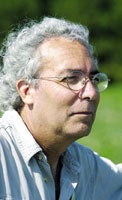Researchers aim at heat illness among farm workers
GREENVILLE, N.C. (July 17, 2002) — During the last half of June, daytime high temperatures averaged just over 89 degrees. That’s not hot for an hour or so of yard work or a brisk walk. But for eight or nine hours of picking cucumbers, it can be intense.

Farm worker Antonio Simental stoops to pick cucumbers in a Greene County field. Simental is among a group of workers participating in a study on head and farm workers. Photo by Cliff Hollis.
That’s why scientists with the N.C. Agromedicine Institute, a constituent research and education institute of East Carolina University, N.C. State University and N.C. A&T State University, are conducting a three-year study of farm workers and heat stress. Funded by approximately $125,000 in grants from the U.S. Department of Agriculture and the National Institute of Occupational Safety and Health, the study aims to determine human response to environmental heat and work exertion and to identify interventions that help reduce or prevent heat-related illness.
The study began last year, and researchers are finishing the first-year data collection and will soon begin the intervention phase.
Dr. John Sabella, an extension specialist with the N.C. Agromedicine Institute, is leading the study. Dr. Karen Elberson, associate professor with the ECU School of Nursing and Bob McClay, a safety specialist with the ECU Center for Applied Technology, are co-investigators. Medical, nursing and occupational students and others serve as data collectors.
“What we’re finding is that the National Weather Service may say it’s going to be 95 today, but it may be 100 in the field,” Sabella said, attributing the difference to the plant transpiration, soil type and other factors.
Heat can be dangerous. From 1979-1999, excessive heat exposure caused 8,015 deaths in the United States, according to the Centers for Disease Control and Prevention. During this period, more Americans died from extreme heat than from hurricanes, lightning, tornadoes, floods and earthquakes combined.
Heat also affects productivity in workers resulting in a decrease in productivity and a loss of money for workers and employers.
“Especially when we’re in tobacco, if you have one (worker) who gets sick, you have to pull him and then get another from somewhere else to do his work,” said Randy Allen, a Greene County farmer who granted the researchers permission to study workers and conditions in his cucumber field.
Heat stroke is the most serious heat-related illness and is potentially fatal. Heat exhaustion is a milder illness. Workers may also experience heat cramps and heat rash. People suffer heat-related illness when their bodies are unable to compensate and properly cool themselves. The body normally cools itself by sweating, but under some conditions, such as in high humidity, sweating isn’t enough. In such cases, a person’s body temperature rises rapidly. Very high body temperatures may damage the brain or other vital organs.

Dr. John Sabella, study leader. Photo by Cliff Hollis.
Sabella emphasized the study is not intended to create additional regulation. “For growers, we want to help them identify the symptoms of heat stress before it becomes a problem,” Sabella said. “For the workers, we want to produce extension-type materials, in both English and Spanish, describing actions they might take to avoid heat-related illness.”
Though educational materials are ubiquitous during the summer, the fact that people suffer heat-related illnesses shows more education is needed. Plus, the culture of migrant workers requires that materials be presented in a different way to be effective.
“They want to work, work, work,” said Liz Spruill, a migrant specialist who’s helping with the study. Workers are paid by the hour and/or by the piece, so stopping to drink water, rest or go to the bathroom (a natural result of drinking) isn’t a priority. For the study, the scientists are taking precise environmental measurements, including temperature and relative humidity at the crop level and about five feet above the ground.